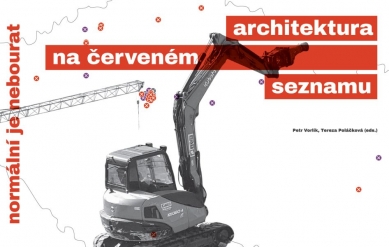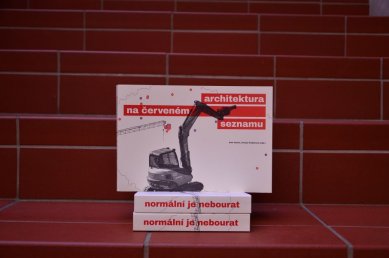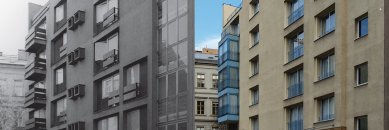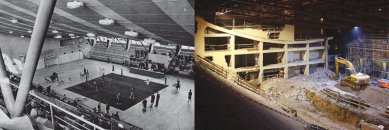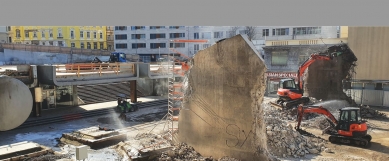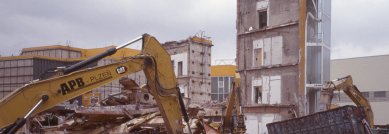
Architecture on the Red List - New Publication from FA CTU
Normal is not to demolish
A new publication titled Architecture on the Red List / Normal is Not to Demolish has been released, which will delight not only experts but also laypeople interested in architecture. Its authors are experts from the Institute of Theory and History of Architecture and students of the Faculty of Architecture at the Czech Technical University in Prague. Using specific examples, they describe the mechanisms of the decline of Czech architecture in the post-war period and call for public discussion.
Among them, they mention the now non-existent Ještěd department store in Liberec, the Transgas buildings, or the mazut heating plant in the Invalidovna housing estate. For example, Transgas (the management center for international gas transportation located next to the Czech Radio building in Prague's Vinohrady) was demolished despite its undeniable architectural and construction qualities and in spite of strong public resistance, including from foreign experts. Petitions and loud protests and demonstrations did not ultimately prevent the demolition of this radical and structurally innovative building that reflected the techno-optimism of its time through its distinctive form.
This is the first publication of its kind that focuses on the disappearing buildings of post-war architecture across all regions. It is not, of course, a complete overview of the lost or endangered architectural heritage from the post-war era. The buildings were nominated for the book through a combination of suitable project proposals offered by selected academics and doctoral students from the Faculty of Architecture, and the personal interest of students from the seminar on Post-War Architecture. The chosen method has added surprising diversity to the content of the book and also offers a number of previously overlooked buildings that are interesting for the upcoming generation of architects. There are also general texts and lists of demolished, devalued, and endangered buildings, as well as listed or still only proposed cultural monuments.
“Our intention is not sentiment or a prickly commentary on the state of society and its inability to responsibly and with a long-term perspective care for the legacy of the past. We would rather use this path to support our common ability to accept and utilize the diversity of historical architecture. Through a concentrated presentation of losses, we also wish to make an urgent appeal. The destruction of stable natural and built environments, established social and economic certainties, occurring in our tense present, shows that the values we walk around daily often only become precious to us at the moment we miss them, and there is no way back. Therefore, let us move beyond these irreversible losses and take the book primarily as a memento and lesson for the future, as a call to save and care for the values that still exist and are critically endangered.” writes the editor of the book, Prof. Petr Vorlík. He considers the continuous emphasis on the architectural qualities and often unexpected generosity of these buildings, as well as the wide possibilities for their further use, to be the most important. Just as the previously rejected historicism, Art Nouveau, functionalism, or the architecture of socialist realism were appreciated over time, a slow turnaround is also occurring in the case of architecture from the period of normalization.
The usual argument for the removal of buildings constructed during the normalization years is their lasting association with propagandistic pride in the successes of the socialist economy. They represent a product of the era when the “boring panel housing estates” were created and in which the quality of construction and society “hit rock bottom.” A significant portion of the public, therefore, even thirty years after the Velvet Revolution, demands the erasure of these past mistakes and a swift replacement with something more contemporary. However, along with the shortcomings, high-quality architectural works are often removed as well. The real reasons for demolitions – especially pragmatic commercial exploitation of the city – usually remain unspoken. “If we were to demolish everything built during socialism, would that mean burying the Prague metro? Would we remove the key highway from Prague to Brno? Would we demolish most of the hospitals, schools, cultural and sports buildings? Certainly not. Therefore, it is necessary to seek alternatives. The world is not for single use. The energy invested in architecture should last longer than the narrowly limited interest of the contemporary, trend-driven world,” explains Prof. Petr Vorlík.
The book can be purchased at the University Bookstore of Professional Literature at the National Technical Library, Technická 6, Prague 6, or in its e-shop.
Architecture on the Red List / Normal is Not to Demolish
Editors: Petr Vorlík, Tereza Poláčková
Published by the Czech Technical University publishing house in December 2020
288 pages
ISBN: 978-80-01-06759-8
The book was created with financial support from the Faculty of Architecture at CTU and as an outcome of the project Post-War Architecture - Critically Endangered Species (IP RPMT 2019 and IP RPMT 2020) and the project Architecture of the Eighties in the Czech Republic - Individuality, Identity, and Parallel Reflections Against the Background of Normalization (NAKI II).
More information >
Among them, they mention the now non-existent Ještěd department store in Liberec, the Transgas buildings, or the mazut heating plant in the Invalidovna housing estate. For example, Transgas (the management center for international gas transportation located next to the Czech Radio building in Prague's Vinohrady) was demolished despite its undeniable architectural and construction qualities and in spite of strong public resistance, including from foreign experts. Petitions and loud protests and demonstrations did not ultimately prevent the demolition of this radical and structurally innovative building that reflected the techno-optimism of its time through its distinctive form.
This is the first publication of its kind that focuses on the disappearing buildings of post-war architecture across all regions. It is not, of course, a complete overview of the lost or endangered architectural heritage from the post-war era. The buildings were nominated for the book through a combination of suitable project proposals offered by selected academics and doctoral students from the Faculty of Architecture, and the personal interest of students from the seminar on Post-War Architecture. The chosen method has added surprising diversity to the content of the book and also offers a number of previously overlooked buildings that are interesting for the upcoming generation of architects. There are also general texts and lists of demolished, devalued, and endangered buildings, as well as listed or still only proposed cultural monuments.
“Our intention is not sentiment or a prickly commentary on the state of society and its inability to responsibly and with a long-term perspective care for the legacy of the past. We would rather use this path to support our common ability to accept and utilize the diversity of historical architecture. Through a concentrated presentation of losses, we also wish to make an urgent appeal. The destruction of stable natural and built environments, established social and economic certainties, occurring in our tense present, shows that the values we walk around daily often only become precious to us at the moment we miss them, and there is no way back. Therefore, let us move beyond these irreversible losses and take the book primarily as a memento and lesson for the future, as a call to save and care for the values that still exist and are critically endangered.” writes the editor of the book, Prof. Petr Vorlík. He considers the continuous emphasis on the architectural qualities and often unexpected generosity of these buildings, as well as the wide possibilities for their further use, to be the most important. Just as the previously rejected historicism, Art Nouveau, functionalism, or the architecture of socialist realism were appreciated over time, a slow turnaround is also occurring in the case of architecture from the period of normalization.
The usual argument for the removal of buildings constructed during the normalization years is their lasting association with propagandistic pride in the successes of the socialist economy. They represent a product of the era when the “boring panel housing estates” were created and in which the quality of construction and society “hit rock bottom.” A significant portion of the public, therefore, even thirty years after the Velvet Revolution, demands the erasure of these past mistakes and a swift replacement with something more contemporary. However, along with the shortcomings, high-quality architectural works are often removed as well. The real reasons for demolitions – especially pragmatic commercial exploitation of the city – usually remain unspoken. “If we were to demolish everything built during socialism, would that mean burying the Prague metro? Would we remove the key highway from Prague to Brno? Would we demolish most of the hospitals, schools, cultural and sports buildings? Certainly not. Therefore, it is necessary to seek alternatives. The world is not for single use. The energy invested in architecture should last longer than the narrowly limited interest of the contemporary, trend-driven world,” explains Prof. Petr Vorlík.
The book can be purchased at the University Bookstore of Professional Literature at the National Technical Library, Technická 6, Prague 6, or in its e-shop.
Architecture on the Red List / Normal is Not to Demolish
Editors: Petr Vorlík, Tereza Poláčková
Published by the Czech Technical University publishing house in December 2020
288 pages
ISBN: 978-80-01-06759-8
The book was created with financial support from the Faculty of Architecture at CTU and as an outcome of the project Post-War Architecture - Critically Endangered Species (IP RPMT 2019 and IP RPMT 2020) and the project Architecture of the Eighties in the Czech Republic - Individuality, Identity, and Parallel Reflections Against the Background of Normalization (NAKI II).
More information >
The English translation is powered by AI tool. Switch to Czech to view the original text source.
